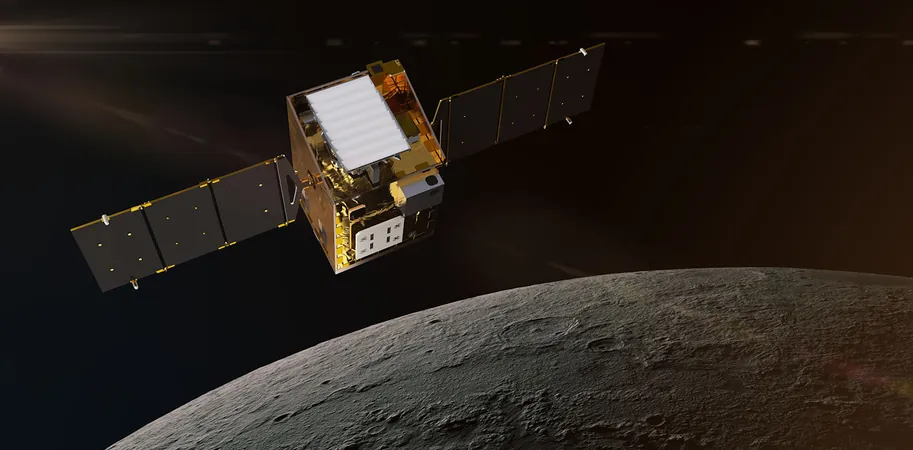
NASA's Lunar Trailblazer: The Groundbreaking Mission Set to Transform Our Understanding of the Moon's Water in 2025
2024-12-29
Author: Emily
NASA's Historic Return to the Moon
NASA is gearing up for a historic return to the Moon with its Artemis II mission, scheduled to send astronauts back to our celestial neighbor no earlier than April 2026. The last humans set foot on the lunar surface during the Apollo 17 mission in 1972, making this upcoming journey a significant milestone in space exploration.
Artemis II and Lunar Preparations
Artemis II will leverage NASA's powerful Space Launch System rocket, ensuring that astronauts embark on a rigorous exploration of the Moon via the Orion spacecraft—successfully tested during the Artemis I mission. Before this monumental crewed expedition, NASA plans to deploy two important missions aimed at exploring the lunar south pole—an area rich in resources essential for sustaining human presence on the Moon and for future scientific advancements.
One of these pivotal missions is Lunar Trailblazer, a satellite set to revolutionize our understanding of the Moon’s surface and its water resources. As scientists, like planetary geologist Bethany Ehlmann, lead this innovative project, the mission aims to provide crucial insights into the formation and behavior of water on rocky bodies in our solar system.
PRIME-1 and Lunar Trailblazer: Dual Space Missions
Scheduled for launch in January 2025, PRIME-1 (Polar Resources Ice Mining Experiment) will feature a lunar lander equipped with two specialized instruments: TRIDENT, which will drill into the lunar soil for samples, and MSOLO, designed to analyze the chemical makeup and water content of these samples.
In conjunction with PRIME-1, the Lunar Trailblazer will also be launched on the same Falcon 9 rocket. This strategy not only maximizes cost efficiency—akin to a multimillion-dollar satellite rideshare pooling—but is also a testament to modern advancements in space technology.
Cost-Effective Innovations
Lunar Trailblazer is part of NASA’s Small, Innovative Mission for Planetary Exploration (SIMPLEx) program, focusing on low-cost but high-impact scientific exploration missions. With an operation budget of approximately $80 million, it exemplifies how smaller missions can yield significant scientific results while minimizing expenses compared to traditional missions, which can reach budgets of upwards of $500 million.
The development of SmallSats—compact satellites designed for specific tasks—has enabled trails like this to flourish. These smaller spacecraft can gather critical data that contribute to a larger understanding of lunar geology and the potential for discovering resources.
Unlocking the Mystery of Lunar Water
The search for water on the Moon isn't new. It has fascinated scientists for centuries. Interest surged notably in the mid-17th century, and by the 1990s, NASA's Clementine mission made groundbreaking detections of water sources on the Moon, identifying ice in shadowed regions. Subsequent missions, including Lunar Prospector and Lunar Reconnaissance Orbiter, continued to corroborate the presence of water in various forms.
With Lunar Trailblazer, scientists aim to delve deeper into these findings. The mission is equipped with specialized instruments: the Lunar Thermal Mapper (LTM) to record surface temperatures, and the High-resolution Volatiles and Minerals Moon Mapper (HVM3) to analyze how lunar rocks react to sunlight and distinguish between liquid and solid water.
Scientific Impact and Future Prospects
As the Lunar Trailblazer gathers data over the lunar day, which lasts about 29.5 Earth days, it will help illuminate variations in chemical composition and understand the phases of water on the Moon.
The scientific community theorizes potential origins of this lunar water, from primordial reserves locked within the Moon's mantle to extraterrestrial delivery via asteroids and comets, and even the possibility of solar wind interactions generating surface water.
Lunar Trailblazer stands at the frontier of lunar research, poised to answer the many lingering questions about water on the Moon and further refine our understanding of the Moon's role in our solar system. Keep your eyes on the stars—2025 is set to be an exhilarating year for lunar exploration!









 Brasil (PT)
Brasil (PT)
 Canada (EN)
Canada (EN)
 Chile (ES)
Chile (ES)
 Česko (CS)
Česko (CS)
 대한민국 (KO)
대한민국 (KO)
 España (ES)
España (ES)
 France (FR)
France (FR)
 Hong Kong (EN)
Hong Kong (EN)
 Italia (IT)
Italia (IT)
 日本 (JA)
日本 (JA)
 Magyarország (HU)
Magyarország (HU)
 Norge (NO)
Norge (NO)
 Polska (PL)
Polska (PL)
 Schweiz (DE)
Schweiz (DE)
 Singapore (EN)
Singapore (EN)
 Sverige (SV)
Sverige (SV)
 Suomi (FI)
Suomi (FI)
 Türkiye (TR)
Türkiye (TR)
 الإمارات العربية المتحدة (AR)
الإمارات العربية المتحدة (AR)